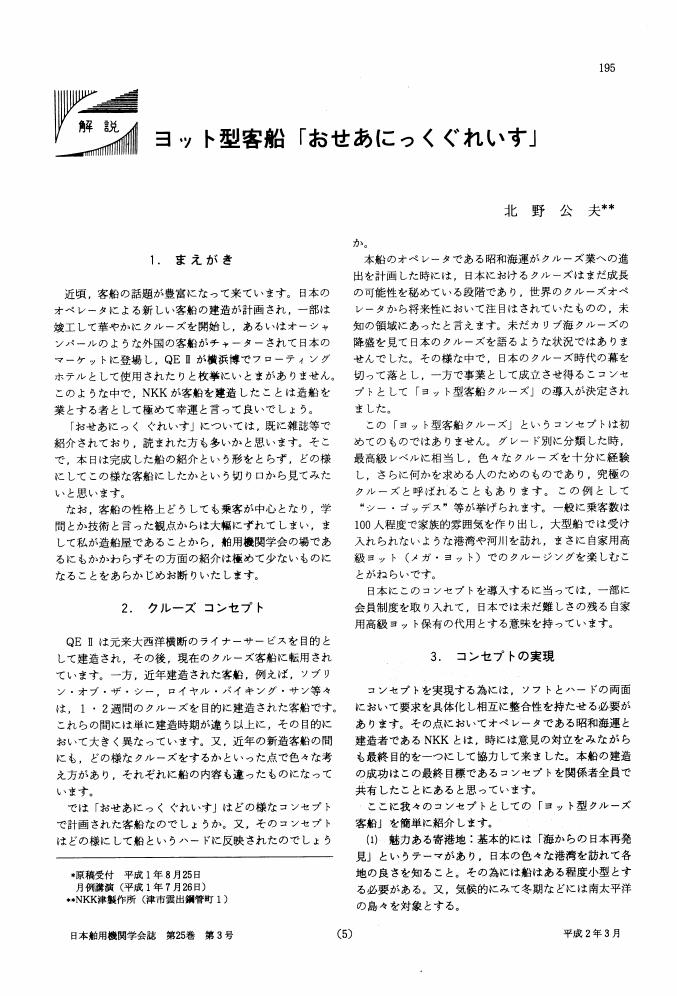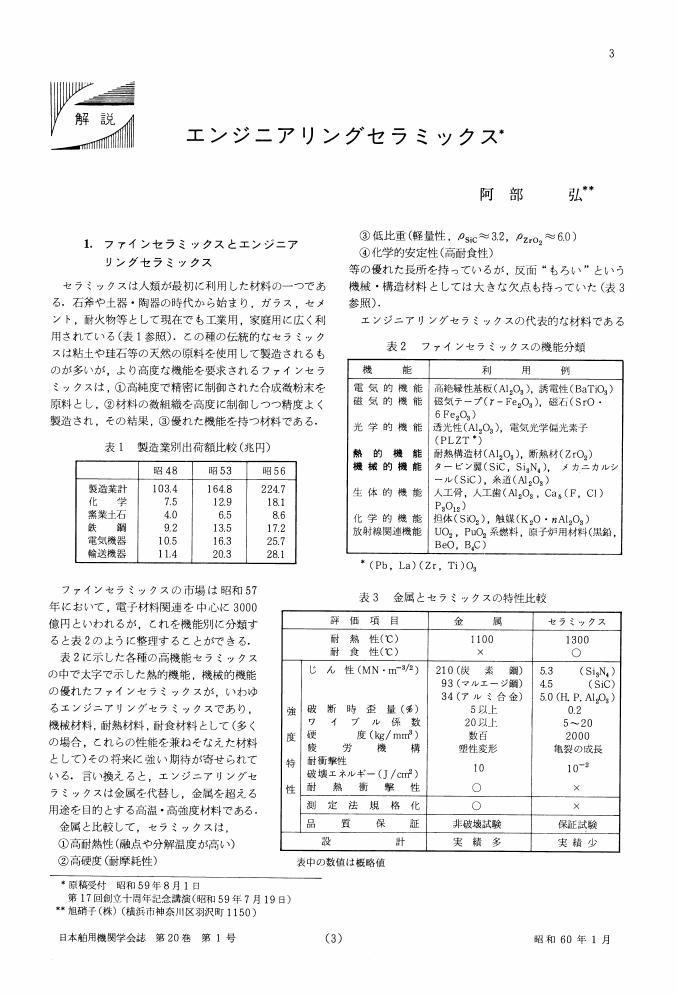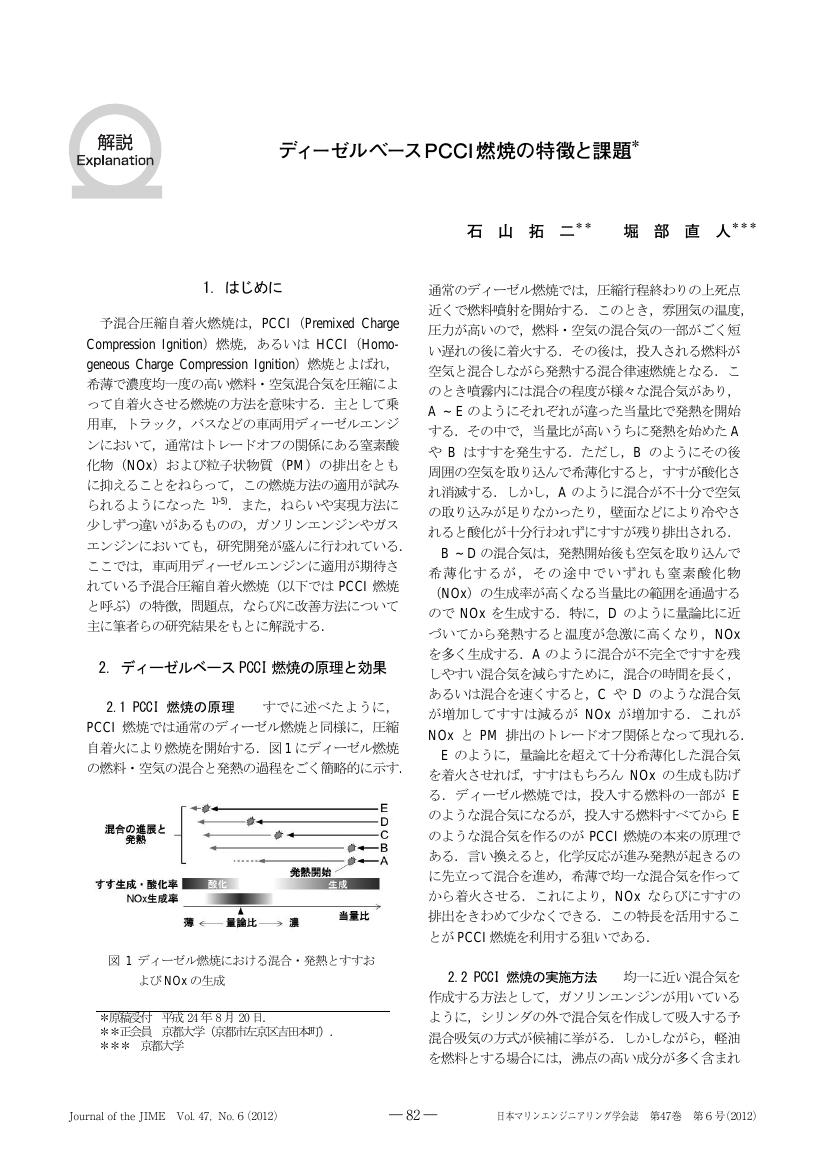1 0 0 0 OA 停止性能推定における主機・プロペラ遊転期間の影響について
- 著者
- 高木 道雄
- 出版者
- 公益社団法人 日本マリンエンジニアリング学会
- 雑誌
- マリンエンジニアリング (ISSN:13461427)
- 巻号頁・発行日
- vol.38, no.10, pp.688-695, 2003-10-01 (Released:2010-05-31)
- 参考文献数
- 1
Through the past studies, it has been pointed out that the duration of free rotating period of propulsion shafting system may affect the stopping ability of the ships. However, in the studies of predicting stopping ability of the ships, more specifically in the predicting stopping distances of the ships, it is a common practice to treat the free rotating period as a certain fixed length of time, or to neglect as it is short.It may be one of the reasons why current simplified and practical predicting methods of stopping ability sometimes show greater deviations between the prediction and the actual result.In order to solve such problems, at this time, the duration of free rotating period have been assessed for actual data of the ships with diesel main propulsion engines to grasp current situation, the scenario of free rotating of propulsion shafting system has been considered, and based on which how the free rotating period affects the stopping ability has been considered.In addition, possible predicting method taking essential feature of free rotating of propulsion shafting system into account based on practical and reasonable approximation has been considered, using which trail calculations have been carried out on the sample data of 132 vessels. Deviations between predictions and actual results have been improved compared with conventional method.
1 0 0 0 OA 舶用主機・発電用ガスタービンについて
- 著者
- 岩本 敏昭
- 出版者
- 公益社団法人 日本マリンエンジニアリング学会
- 雑誌
- 日本舶用機関学会誌 (ISSN:03883051)
- 巻号頁・発行日
- vol.23, no.9, pp.578-587, 1988-09-01 (Released:2010-05-31)
- 参考文献数
- 13
1 0 0 0 OA 主機潤滑油サンプタンク設計マニュアル
- 著者
- 機関第三研究委員会
- 出版者
- 公益社団法人 日本マリンエンジニアリング学会
- 雑誌
- 日本舶用機関学会誌 (ISSN:03883051)
- 巻号頁・発行日
- vol.28, no.12, pp.752-758, 1993-12-01 (Released:2010-05-31)
This paper shows the design manual of main engine lubricating oil sump tank.
1 0 0 0 OA 幕末期輸入船とその主機
- 著者
- 坂本 賢三
- 出版者
- 公益社団法人 日本マリンエンジニアリング学会
- 雑誌
- 日本舶用機関学会誌 (ISSN:03883051)
- 巻号頁・発行日
- vol.18, no.6, pp.456-464, 1983-06-01 (Released:2010-05-31)
- 参考文献数
- 27
A role of imported steamships and their main engines at the beginning of modern industry in Japan is scrutinized and examined in this paper.Before the first arrival of steamship to Japan in the year 1853, some of Japanese artisans had endeavoured to make up a side-lever engine only in dependence on a translation of a Dutch textbook. They successfully built up a steamship and it operated well in 1854, but these trials were suspended and many western steamships were imported, because it was so difficult to make up complicated marine engines such as an oscillating engine without machine-tools and related industry. In addition, there was no time to prepare for the foreign pressure. But the importation of steamships played a great part for the progress of Japanese marine engineering.At that time, in Europe the marine engine had been in the era of innovation, for example, the spread of oscillating engine or double-cylinder engine etc., and also the change from paddle wheel to screw in propeller. Steamships equipped new-type engines were imported successively, and Japan could keep up with the times. In 1862, excellent engineers went abroad for study and joined in construction of an ordered ship in the Netherlands, thus they could learn in practice. Using the imported ships, Japanese engineers grew accustomed to operation and repair of new machines. There was a rather good understanding of the necessity of dockyards for repair and such shipyards made a contribution to the development of marine engine in Japan.
1 0 0 0 OA ヨット型客船「おせあにっくぐれいす」
- 著者
- 北野 公夫
- 出版者
- 公益社団法人 日本マリンエンジニアリング学会
- 雑誌
- 日本舶用機関学会誌 (ISSN:03883051)
- 巻号頁・発行日
- vol.25, no.3, pp.195-202, 1990-03-01 (Released:2010-05-31)
1 0 0 0 OA ディーゼル噴霧の粒径に及ぼす燃料粘度の影響
- 著者
- 廣安 博之 新井 雅隆 田端 道彦
- 出版者
- 公益社団法人 日本マリンエンジニアリング学会
- 雑誌
- 日本舶用機関学会誌 (ISSN:03883051)
- 巻号頁・発行日
- vol.20, no.3, pp.194-202, 1985-03-01 (Released:2010-05-31)
- 参考文献数
- 11
- 被引用文献数
- 6
To study the effect of fuel viscosity, injection pressure and surface tension on the mean droplet size and spray angle, the diesel fuel spray droplets were measured by a Laser diffraction technique. Several kinds of glycerine solution with water and residual fuel oil were used. The tests were carried out over a wide range of injection pressure [3 to 90 MPa (30.6 to 917.7 kgf/cm2) ] and of kinematic viscosity of liquid [1×10-6 to 200×10-6 m2 /s (1 to 200 cSt) ] at ambient pressure of 3 MPa (30.6 kgf/cm2) .The main results obtained are as follows:(1) Sauter mean diameter increases with increasing kinematic viscosity of liquid, but decreases with increasing injection pressure. There are an upper limit of viscosity and a lower limit of the pressure to produce a fine spray.(2) At high injection pressure, the effect of viscosity on Sauter mean diameter still remains, but the viscosity has no effect on the spray angle.(3) When the viscosity is the same at low injection pressure, Sauter mean diameter of glycerine solution spray is larger than that of residual oil. Surface tension has no effect on the Sauter mean diameter at high injection pressure.
1 0 0 0 OA エンジニアリングセラミックス*
- 著者
- 阿部 弘
- 出版者
- 公益社団法人 日本マリンエンジニアリング学会
- 雑誌
- 日本舶用機関学会誌 (ISSN:03883051)
- 巻号頁・発行日
- vol.20, no.1, pp.3-7, 1985-01-01 (Released:2010-05-31)
1 0 0 0 OA ベイズの定理と信頼性への応用
- 著者
- 堀籠 教夫
- 出版者
- 公益社団法人 日本マリンエンジニアリング学会
- 雑誌
- 日本舶用機関学会誌 (ISSN:03883051)
- 巻号頁・発行日
- vol.25, no.2, pp.91-97, 1990-02-01 (Released:2010-05-31)
- 参考文献数
- 10
1 0 0 0 OA 有害廃棄物の越境移動の規制 -日本の輸出規制に焦点をあてて
- 著者
- 鶴田 順
- 出版者
- 公益社団法人 日本マリンエンジニアリング学会
- 雑誌
- マリンエンジニアリング (ISSN:13461427)
- 巻号頁・発行日
- vol.48, no.1, pp.44-47, 2013-01-01 (Released:2014-02-28)
- 参考文献数
- 6
1 0 0 0 OA 海水中気泡群の終端速度に関する研究
- 著者
- 吉田 昭仁 久郷 信俊 石田 憲治 佐藤 圭司 黒田 真生
- 出版者
- 公益社団法人 日本マリンエンジニアリング学会
- 雑誌
- マリンエンジニアリング (ISSN:13461427)
- 巻号頁・発行日
- vol.38, no.10, pp.696-702, 2003-10-01 (Released:2010-05-31)
- 参考文献数
- 6
Most of industrial plants such petrochemical plant, LNG plant, and power plant, usually use water for the process cooling. Especially, in a large industrial plant, a large amount of seawater is used as the cooling media, and finally discharged to sea area through a seawater discharge basin.The seawater discharge basin has a weir to keep the sufficient backpressure of the seawater cooling system. In the seawater discharge basin, the seawater overflows the weir and falls down into the seawater flow at the downstream of weir. Then, the air is entrained into the seawater at the downstream of weir due to the waterfall flow and air bubbles with various sizes and shapes are generated in seawater.From the viewpoint of an environmental conservation, it is often required to eliminate air bubbles contained in cooling seawater discharged from industrial plants to sea area. There is a de-aeration chamber as a technology to separate these bubbles from the discharged seawater.To perform the optimum design of the de-aeration chamber, it is important to grasp the volume and size distribution of air bubbles generated in the seawater by the waterfall flow at the weir, and a terminal velocity of air bubbles rising in seawater.Therefore, in this study, the terminal velocities of any bubble in swarm of air bubbles rising in stagnant seawater, were measured in the region of low void fraction.
- 著者
- 石原 孟
- 出版者
- 公益社団法人 日本マリンエンジニアリング学会
- 雑誌
- マリンエンジニアリング (ISSN:13461427)
- 巻号頁・発行日
- vol.50, no.1, pp.14-19, 2015-01-01 (Released:2016-01-27)
- 参考文献数
- 5
- 被引用文献数
- 2
- 著者
- 小松 正夫 太田 真 熊本 均 伊藤 弘人
- 出版者
- 公益社団法人 日本マリンエンジニアリング学会
- 雑誌
- マリンエンジニアリング (ISSN:13461427)
- 巻号頁・発行日
- vol.50, no.1, pp.20-23, 2015-01-01 (Released:2016-01-27)
- 参考文献数
- 11
- 著者
- 北小路 結花
- 出版者
- 公益社団法人 日本マリンエンジニアリング学会
- 雑誌
- マリンエンジニアリング (ISSN:13461427)
- 巻号頁・発行日
- vol.50, no.1, pp.24-29, 2015-01-01 (Released:2016-01-27)
- 参考文献数
- 1
1 0 0 0 OA 高EGR直接噴射式ディーゼル機関における燃焼過程の化学動力学モデルに基づく3次元数値解析
- 著者
- 脇坂 知行 藤本 英史 松川 洋介 高田 洋吾
- 出版者
- 公益社団法人 日本マリンエンジニアリング学会
- 雑誌
- マリンエンジニアリング (ISSN:13461427)
- 巻号頁・発行日
- vol.43, no.6, pp.971-976, 2008-11-01 (Released:2010-05-31)
- 参考文献数
- 10
- 被引用文献数
- 2
The purpose of this study is to establish a practical method based on a chemical kinetic model for three-dimensional numerical analysis of the combustion process in direct-injection diesel engines. For saving computational time, a reduced elementary reaction scheme for diesel fuel was constructed. The basis was the Golovitchev detailed elementary reaction scheme. Using an original engine combustion simulation code GTT-CHEM along with the reduced elementary reaction scheme, the combustion process was three-dimensionally analyzed in a direct-injection diesel engine with high-EGR ratios.As a result, the combustion process and NO emission were quantitatively predicted by estimating the initial gas state and the initial composition appropriately. The emission tendency of soot was reasonably assessed by means of φ-T maps.
1 0 0 0 OA ディーゼルベース PCCI 燃焼の特徴と課題
- 著者
- 石山 拓二 堀部 直人
- 出版者
- 公益社団法人 日本マリンエンジニアリング学会
- 雑誌
- マリンエンジニアリング (ISSN:13461427)
- 巻号頁・発行日
- vol.47, no.6, pp.859-864, 2012-11-01 (Released:2013-12-26)
- 参考文献数
- 24
- 被引用文献数
- 1 4
1 0 0 0 OA 舶用プロペラのCFD解析
- 著者
- 川村 隆文
- 出版者
- 公益社団法人 日本マリンエンジニアリング学会
- 雑誌
- マリンエンジニアリング (ISSN:13461427)
- 巻号頁・発行日
- vol.48, no.5, pp.623-628, 2013-09-01 (Released:2014-09-02)
- 参考文献数
- 17
1 0 0 0 OA Java/JavaScript
- 著者
- 春海 和佳
- 出版者
- 公益社団法人 日本マリンエンジニアリング学会
- 雑誌
- マリンエンジニアリング (ISSN:13461427)
- 巻号頁・発行日
- vol.36, no.12, pp.1016-1017, 2001-12-01 (Released:2010-05-31)
1 0 0 0 OA にっぽん丸の搭載機器について
- 著者
- 火置 将一
- 出版者
- 公益社団法人 日本マリンエンジニアリング学会
- 雑誌
- マリンエンジニアリング (ISSN:13461427)
- 巻号頁・発行日
- vol.47, no.2, pp.203-207, 2012-03-01 (Released:2013-10-30)
1 0 0 0 OA 戦前の舶用補機械発達史
- 著者
- 日本舶用機関史編集委員会補機専門委員会
- 出版者
- 公益社団法人 日本マリンエンジニアリング学会
- 雑誌
- 日本舶用機関学会誌 (ISSN:03883051)
- 巻号頁・発行日
- vol.21, no.6, pp.372-382, 1986-06-01 (Released:2010-05-31)
This paper is an excert from the manuscripts written by the marine auxiary equipment subcommittee of the marine Engineering history committee of the MESJ. The manuscript was completed after 10 years of hard wark. But has not yet been pubbished because of various aduerse conditions. This paper is one of the serial papers which will appear in this Journal twice a year to introduce the content of the manuscript to menbers of MESJ.This paper are consist of Deck machinery, Steering gear systems, and refrigerator and air conditioning systems.Marine machinery equipment developed according to ship building progress. They were almost imported from foreign country in Meiji and Taishou Era, but a some of large sized passenger vessels used the imported products on account of a lack of reliability in Japanese products.The marine machinery equipments developed rapidly own design and unique products by the World War II.
1 0 0 0 OA 特集号「張り巡らされるセンサー・計測技術」によせて
- 著者
- 木船 弘康
- 出版者
- 公益社団法人 日本マリンエンジニアリング学会
- 雑誌
- マリンエンジニアリング (ISSN:13461427)
- 巻号頁・発行日
- vol.46, no.2, pp.180-180, 2011 (Released:2013-10-23)












